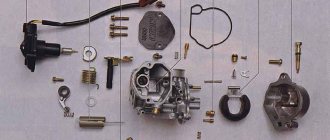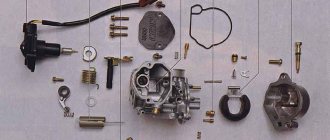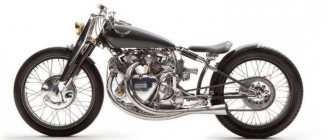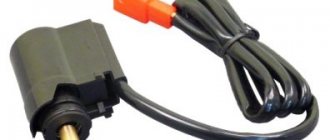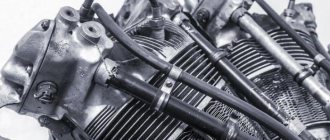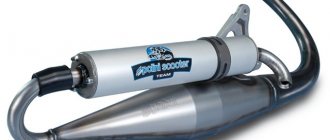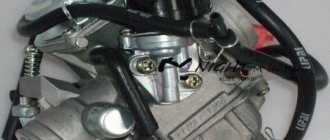Setting up carburetors using the example of Mikuni VM26 and Yoshimura Mikuni TM-MJN 22/24/26
The air-fuel mixture is the ratio of fuel to air.
By increasing the amount of air, we reduce the proportion of fuel; the air-fuel mixture becomes lean. By reducing the amount of air, we increase the proportion of fuel, the air-fuel mixture becomes richer. For proper engine operation, it is necessary to establish the optimal air-fuel ratio for it by correctly setting the carburetor. The following factors influence the setting: air density, changes in temperature and humidity, pressure (altitude above sea level). The following table shows the behavior of the air-fuel mixture depending on changes in the surrounding weather:
Symptoms of a rich mixture:
Symptoms of a lean mixture:
Starting pump
The starting pump consists of a cylinder, a piston with a ring and two valves. The starting pump is connected to the fuel supply line, between the fuel tank and the fuel pump. As the piston is pulled out of the cylinder, the intake valve opens and the exhaust valve closes due to the vacuum created in the cylinder. In this case, the fuel enters the cylinder, filling its internal cavity. When the piston moves back, increased pressure is created in the cylinder, closing the intake valve and opening the exhaust valve. The fuel is pushed out of the cylinder by a piston. A portion of fuel from the starting pump is supplied to the intake manifold. Usually two or three strokes are enough. When the engine is hot, there is no need to use the starting pump. When the weather is very cold, it is recommended to rotate the piston three to four turns before bleeding. This will prevent possible jamming of the piston during operation.
Operating principle of VM26 and TM-MJN22/24/26 carburetors
Fig.1 Operation of the propeller (AS)
A needle is installed in the throttle valve, which regulates the amount of gasoline supplied to the main channel to mix it with air. The needle affects the quality of the mixture in the throttle opening range from 1/8 to fully open. VM type carburetors have a regular needle with five grooves for adjustment (Fig. 2).
Fig.3 Differences between needle and tube
The influence of all carburetor systems on the qualitative composition of the mixture depending on the degree of throttle opening on the TM-MJN24 can be seen in Figure 4. This relationship is also valid for VM26 carburetors.
Fig. 4 The influence of different TM-MJN24 carburetor systems on the quality of the mixture
Mikuni carburetor
In this review, we would like to tell you about the Mikuni carburetor, namely, the VM 22 model. This device is produced by one of the Japanese companies, which leads to initial thoughts that the mechanism is quite reliable. And indeed, as practice shows, Mikuni carburetors can serve you for quite a long time and not bother you with constant breakdowns during operation. The secret of such reliability lies in an indecently simple device. Some might say that such a simple design simply cannot be reliable, and they would be wrong.
Many owners of motorcycles on which a Mikuni carburetor was installed talked about how good this unit is. By the way, it is also worth saying that the Mikuni VM 22 model is usually installed on motorcycles with an engine with a volume of 125 cm3. Among such motorcycles are the Honda CBR 125R, Yamaha YBR 125 and other motorcycles from Japanese manufacturers.
Installation Guide
Important! Adjust the carburetor on a warm engine, and then do a test drive. Use a spark plug with a heat rating recommended by the engine manufacturer.
The fuel mixture is the ratio of gasoline and air. By increasing the amount of air and decreasing the proportion of fuel, we make the air-fuel mixture leaner. By reducing the amount of air and increasing the proportion of fuel, we make the mixture richer. For all engine operating modes, it is necessary to adjust the optimal ratio of gasoline and air.
The mixture ratio in these positions can be adjusted by replacing the main jet. The higher the main jet number, the richer the mixture becomes. Depending on the engine and muffler parameters, select the most suitable jet to achieve maximum speed.
The mixture ratio at these throttle positions can be adjusted by placing the E-ring at different needle positions. The air-fuel mixture becomes richer when the E-ring is moved down from the 1st to the 5th groove.
The propeller regulates the air flow while the engine is spinning at low speed (idling).
Loosen the idle screw (at the throttle body) until you get a stable idle speed. Again, adjust the propeller position to obtain high rpm.
Check if you have selected the correct auxiliary jet. The engine should accelerate smoothly from idle to low speed.
Source
MY MOTORCYCLE
Mikuni is good for everyone for Izh-PS - the motorcycle rides well with it and consumes little gasoline. The only drawback of the carburetor is that a failure occurs at the moment when the throttle valve is only slightly opened. And, as luck would have it, on the highway this mode occurs at speeds of 80-100 km/h. I let off the gas a little. added again - and the engine, with a loud detonation, signals that the mixture is too lean. If you drive in this mode for a long time, it happens that the piston burns out. You can turn the mixture quality screw at idle as much as you like and move the needle in the throttle valve up and down - simply adjusting the carburetor cannot eliminate this defect. If you reduce the ignition timing, you may get rid of detonation, but then the engine power will decrease.”
When the engine is idling, air passes at high speed through the narrow gap between the edge of the spool and the wall of the mixing chamber. Its speed and, accordingly, the vacuum in the sprayer zone are minimal. This means that fuel enters the engine only from the idle system. When the throttle is raised to a quarter stroke or higher, the air flow velocity is sufficient to suck fuel from the atomizer. Its quantity determines the gap between the needle and the sprayer. And in the last quarter of the throttle stroke, only the main metering system nozzle is responsible for fuel supply.
What regulates the composition of the mixture in the first quarter? It turns out that everything depends on the shape of the spool. More precisely, from the height of the cutout in its edge, which is on the side of the air filter. If the cutout is small. with a slight rise of the spool, the air flow velocities under both of its edges will be close in magnitude. which means that a vacuum will sooner arise near the nozzle, sufficient for fuel to flow through it - the mixture will begin to enrich earlier than necessary. If the cutout is too large, it’s the other way around. So, for some reason, this Mikuni has a cutout that’s too big—hence the “failure.” The idle system is no longer able to provide fuel to the engine, and the main metering system has not yet come online. Hence the depletion and detonation. It would seem that nothing could be simpler: change the size of the cutout in the right direction - and everything will fall into place. But this is easy to do; if the cutout is small, the spool can be filed down. This is how I managed to get Jikova working from the cross-country CZ (“Let’s cheer up the “old man” “Moto” No. 2-2005). But how do you increase the Mikuni spool? I racked my brains for a long time until a desperate thought flashed through my mind: it’s possible to increase the vacuum in the sprayer area in another way! For example, by installing some kind of curtain in front of the needle.
The Mikuni carburetor has a spool position when the idle system no longer supplies fuel, and the main engine has not yet started working (in the figure on the left). The bolt in the spool (1 in the figure on the right and in the photo) creates additional vacuum in the area of the metering needle, the gas pump begins to work with a smaller lift of the spool; The figure on the left shows an excessively large cutout of the spool (2). What causes the engine to become lean during transient conditions?
My heart bled when I drilled a hole in the spool next to the metering needle on the side of the air filter. I cut an M5 thread in it and screwed in the bolt. And it helped! It created resistance to the air flow, a vacuum arose behind it - and additional gasoline was used! Tightening and unscrewing the bolt, I found a position so that the hole disappeared and the fuel consumption remained almost the same as before the alteration.
Yuri BATURIN, pos. Suponvvo Bryansk district, Bryansk region
Carburetor Mikuni VM 26
The Mikuni VM 26 carburetor is very common: it is installed on many pit bikes as standard. For example, on a Pitster with a Zongshen 160 engine.
The carburetor is very simple and does not differ much from the same VM 22 structurally. Naturally, there is a difference in the diffuser, this goes without saying: as you can see, even judging by the name, it is 26 mm.
You won't have any problems with installation; it's extremely easy to attach. No adapters or other design complications. Just screw it to the pipe with two M6 bolts - and it’s in place.
The carburetor is based on a regular round valve, so there are no surprises or complications: “Simplicity is the key to reliability” - this, one might say, is the motto of this carburetor. Please note that you will not find an adjustment screw either on the right or on the left, only perhaps the idle speed screw, but the adjustment screw is located at the bottom.
Of course, this is not very convenient, but you get used to everything, especially since you don’t need to adjust the carburetor so often: a couple of times a year you can suffer a little. As you can see, the adjusting screw is located closer to the inlet pipe, and this can only mean one thing - the adjustment of the fuel-air mixture is carried out using more or less fuel supply to the air. We tighten the screw - we lean the mixture, unscrew it - we enrich it. Nothing complicated.
To facilitate starting in the cold season, suction is carried out by means of an air damper and a flag that controls it.
The damper works very simply: we shut off the air supply - we enrich the mixture, since there is less air and more gasoline.
The damper has three operating modes, and, in turn, the control flag also has three fixed positions.
The first position is when the air damper is completely open and there is nothing blocking the passage of air; the flag is raised up.
The second position is designed to warm up the engine, the air damper closes approximately 70% of the air flow, and the mixture becomes rich, there should be no problems with starting. In this position, you should start it early in the morning, when it is still very cold, or after a long period of inactivity. The flag should be in the middle fixed position.
The third position is the lowest. Accordingly, the flag is in the lower fixed position, and the damper almost completely blocks the air flow. This position is required when you need to create a very rich mixture, for example, for starting in sub-zero temperatures.
The carburetor will work well in combination with the YX 150 and YX 160 engines.
Result: The carburetor is quite cheap, but the engine runs properly and smoothly. Naturally, you won’t achieve any kind of super explosive dynamics, but smooth operation and ease of maintenance of the carburetor - very much so.
Source
What is a carburetor and what is its main task?
Before discussing the most interesting new products that you may consider installing on your motorcycle, you need to understand what a carburetor is.
So, a carburetor is a special mechanism that is a component of the power supply system of an internal combustion engine. The main task performed by the carburetor is mixing fuel with air and regulating the amount of combustible mixture entering the engine of a car or motorcycle. Today we can rarely see a carburetor on a car, since with the development of technology a more practical and efficient mechanism has appeared - an injector. However, the carburetor system on a motorcycle is a completely familiar story. The same Mikuni carburetor is found quite often.
When choosing a motorcycle, many people consciously choose a motorcycle with a carburetor fuel supply system. Although the fuel injector is a more modern mechanism, which has some advantages for the average motorcyclist, the carburetor is still in service. As a rule, the carburetor system is chosen by bikers who are fond of stunt riding, where the injector does not allow full control over the motorcycle.
Why is the checkbox needed?
By the way, it’s worth telling a little about why you raise the flag up and why the Mikuni carburetor was equipped with it. The thing is that when the flag is in the upper position, the engine receives more fuel. Consequently, the motorcycle starts running at higher speeds. Using this flag is very helpful in cold times, for example, in autumn or spring. Also, motorcyclists often use it in the morning when the motorcycle has been parked all night.
The flag is necessary so that the biker has the opportunity to quickly start the motorcycle engine and warm it up. And if a cold start in the morning is not so difficult, then starting the engine in the fall is much more difficult. Thanks to the raised flag, you can let the motorcycle run for some time on “choke” and warm up the engine well. Then the flag moves down to the standard position, and now you can begin operation in its usual mode.


